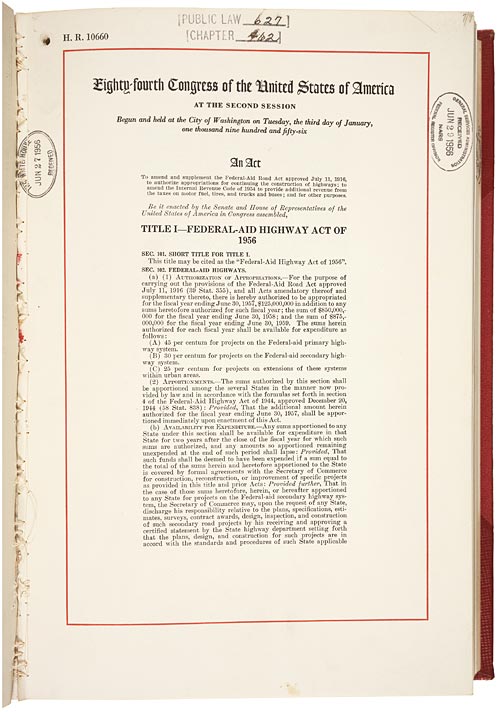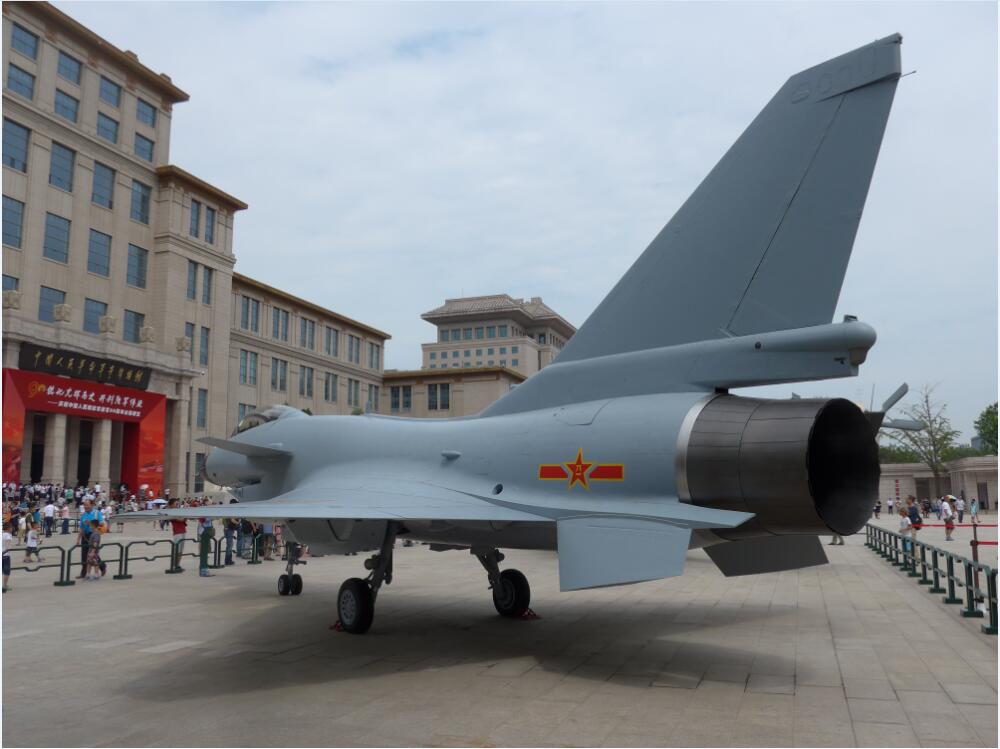STEC Archives, Print Document Division
Curator signature: New Jersey
Format: Archival Records
Object: Archival Records, 84th Congress & Commentary from Dwight D. Eisenhower
Location (if known): Walter Reed Army Medical Center
Time (if known): June 29, 1956

To the Congress of the United States:
Our unity as a nation is sustained by free communication of thought and by easy transportation of people and goods. The ceaseless flow of information throughout the Republic is matched by individual and commercial movement over a vast system of inter-connected highways criss-crossing the country and joining at our national borders with friendly neighbors to the north and the south.
Together, the uniting forces of our communication and transportation systems are dynamic elements in the very name we bear – United States.
The Nation’s highway system is a gigantic enterprise, one of our largest items of capital investment. Generations have gone into its building. Three million, three hundred and sixty-six thousand miles of road, travelled by 58 million motor vehicles, comprise it. The replacement cost of its drainage and bridge and tunnel works is incalculable. One in every seven Americans gains his livelihood and supports his family out of it. But, in large part, the network is inadequate for the nation’s growing needs.
In recognition of this, the Governors in July of last year at my request began a study of both the problem and methods by which the Federal Government might assist the States in its solution. I appointed in September the President’s Advisory Committee on a National Highway Program, headed by Lucius D. Clay, to work with the Governors and to propose a plan of action for submission to the Congress. At the same time, a committee representing departments and agencies of the national Government was organized to conduct studies coordinated with the other two groups. All three were confronted with inescapable evidence that action, comprehensive and quick and forward-looking, is needed.
First: Each year, more than 36 thousand people are killed and more than a million injured on the highways. To the home where the tragic aftermath of an accident on an unsafe road is a gap in the family circle, the monetary worth of preventing that death cannot be reckoned. But reliable estimates place the measurable economic cost of the highway accident toll to the Nation at more than $4.3 billion a year.
Second: The physical condition of the present road net increases the cost of vehicle operation, according to many estimates, by as much as one cent per mile of vehicle travel. At the present rate of travel, this totals more than $5 billion a year. The cost is not borne by the individual vehicle operator alone. It pyramids into higher expense of doing the nation’s business. Increased highway transportation costs, passed on through each step in the distribution of goods, are paid ultimately by the individual consumer.
Third: In case of an atomic attack on our key cities, the road net must permit quick evacuation of target areas, mobilization of defense forces and maintenance of every essential economic function. But the present system in critical areas would be the breeder of a deadly congestion within hours of an attack.
Fourth: Our Gross National Product, about $357 billion in 1954, is estimated to reach over $500 billion in 1965 when our population will exceed 180 million and, according to other estimates, will travel in 81 million vehicles 814 billion vehicle miles that year. Unless the present rate of highway improvement and development is increased, existing traffic jams only faintly foreshadow those of ten years hence.
To correct these deficiencies is an obligation of Government at every level. The highway system is a public enterprise. As the owner and operator, the various levels of Government have a responsibility for management that promotes the economy of the nation and properly serves the individual user. In the case of the Federal Government, moreover, expenditures on a highway program are a return to the highway user of the taxes which he pays in connection with his use of the highways.
Congress has recognized the national interest in the principal roads by authorizing two Federal-aid systems, selected cooperatively by the States, local units and the Bureau of Public Roads.
The Federal-aid primary system as of July 1, 1954, consisted of 234,407 miles, connecting all the principal cities, county seats, ports, manufacturing areas and other traffic generating centers.
In 1944 the Congress approved the Federal-aid secondary system, which on July 1, 1954, totalled 482,972 miles, referred to as farm-to-market roads–important feeders linking farms, factories, distribution outlets and smaller communities with the primary system.
Because some sections of the primary system, from the viewpoint of national interest are more important than others, the Congress in 1944 authorized the selection of a special network, not to exceed 40,000 miles in length, which would connect by routes, as direct as practicable, the principal metropolitan areas, cities and industrial centers, serve the national defense, and connect with routes of continental importance in the Dominion of Canada and the Republic of Mexico.
This National System of Interstate Highways, although it embraces only 1.2 percent of total road mileage, joins 42 State capital cities and 90 percent of all cities over 50,000 population. It carries more than a seventh of all traffic, a fifth of the rural traffic, serves 65 percent of the urban and 45 percent of the rural population. Approximately 37,600 miles have been designated to date. This system and its mileage are presently included within the Federal-aid primary system.
In addition to these systems, the Federal Government has the principal, and in many cases the sole, responsibility for roads that cross or provide access to Federally owned land–more than one-fifth the nation’s area.
Of all these, the Interstate System must be given top priority in construction planning. But at the current rate of development, the Interstate network would not reach even a reasonable level of extent and efficiency in half a century. State highway departments cannot effectively meet the need. Adequate right-of-way to assure control of access; grade separation structures; relocation and realignment of present highways; all these, done on the necessary scale within an integrated system, exceed their collective capacity.
If we have a congested and unsafe and inadequate system, how then can we improve it so that ten years from now it will be fitted to the nation’s requirements?
The obvious responsibility to be accepted by the Federal Government, in addition to the existing Federal interest in our 3,366,000-mile network of highways, is the development of the Interstate System with its most essential urban arterial connections. I have signed H.R. 10660 today for the purposes below.
1. That the Federal Government assume principal responsibility for the cost of a modern Interstate Network to be completed by 1964 to include the most essential urban arterial connections; at an annual average cost of $2.5 billion for the ten year period.
2. That Federal contributions to primary and secondary road systems, now at the rate authorized by the 1954 Act of approximately $525 million annually, be continued.
3. That Federal funds for that portion of the Federal-aid systems in urban areas not on the Interstate System, now approximately $75 million annually, be continued.
4. That Federal funds for Forest Highways be continued at the present $22.5 million per year rate.
5. That Congress be authorized to prioritize any special highway projects immediately pressing, including that of the Strategic Highway Network.
DWIGHT D. EISENHOWER






